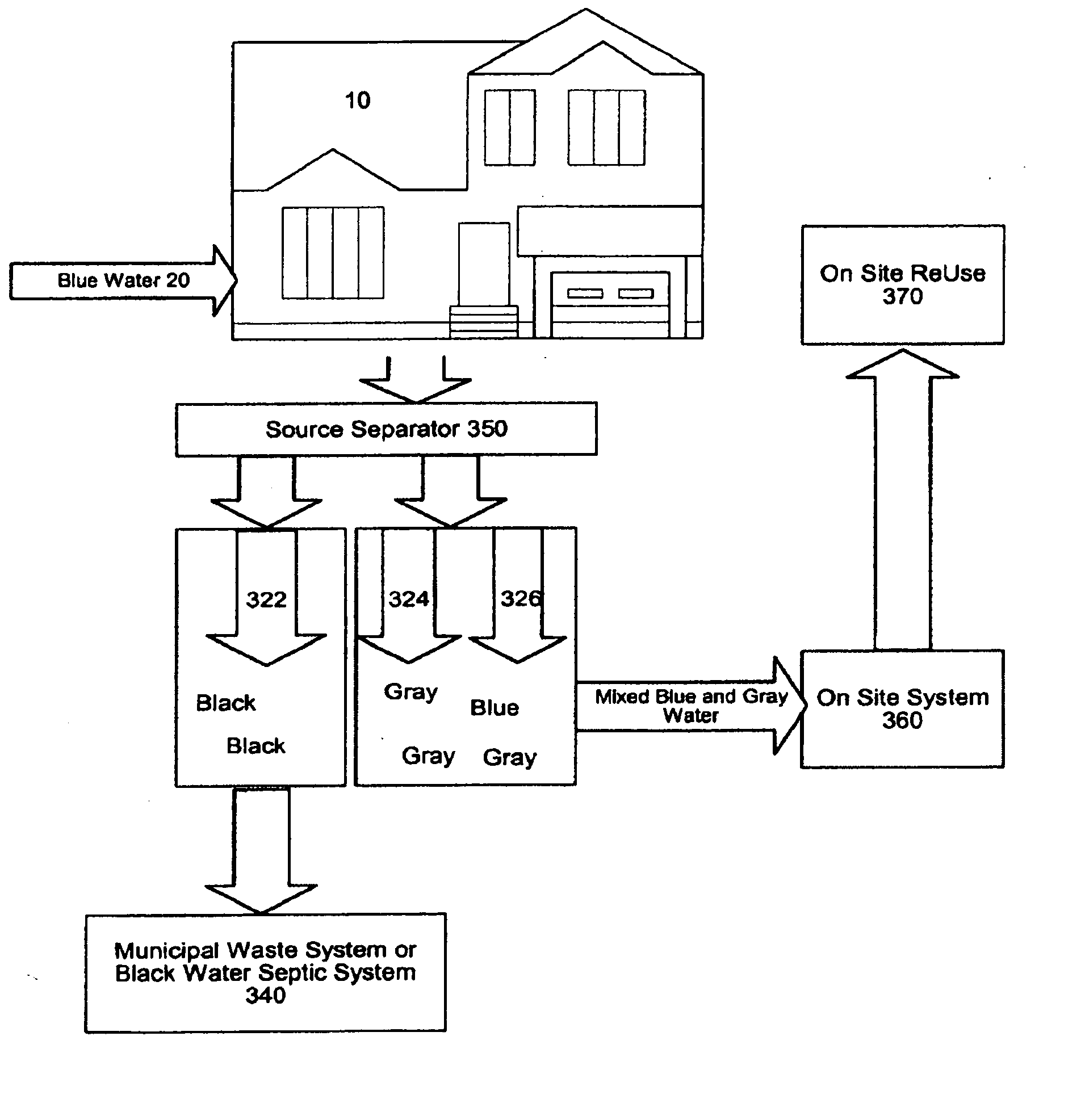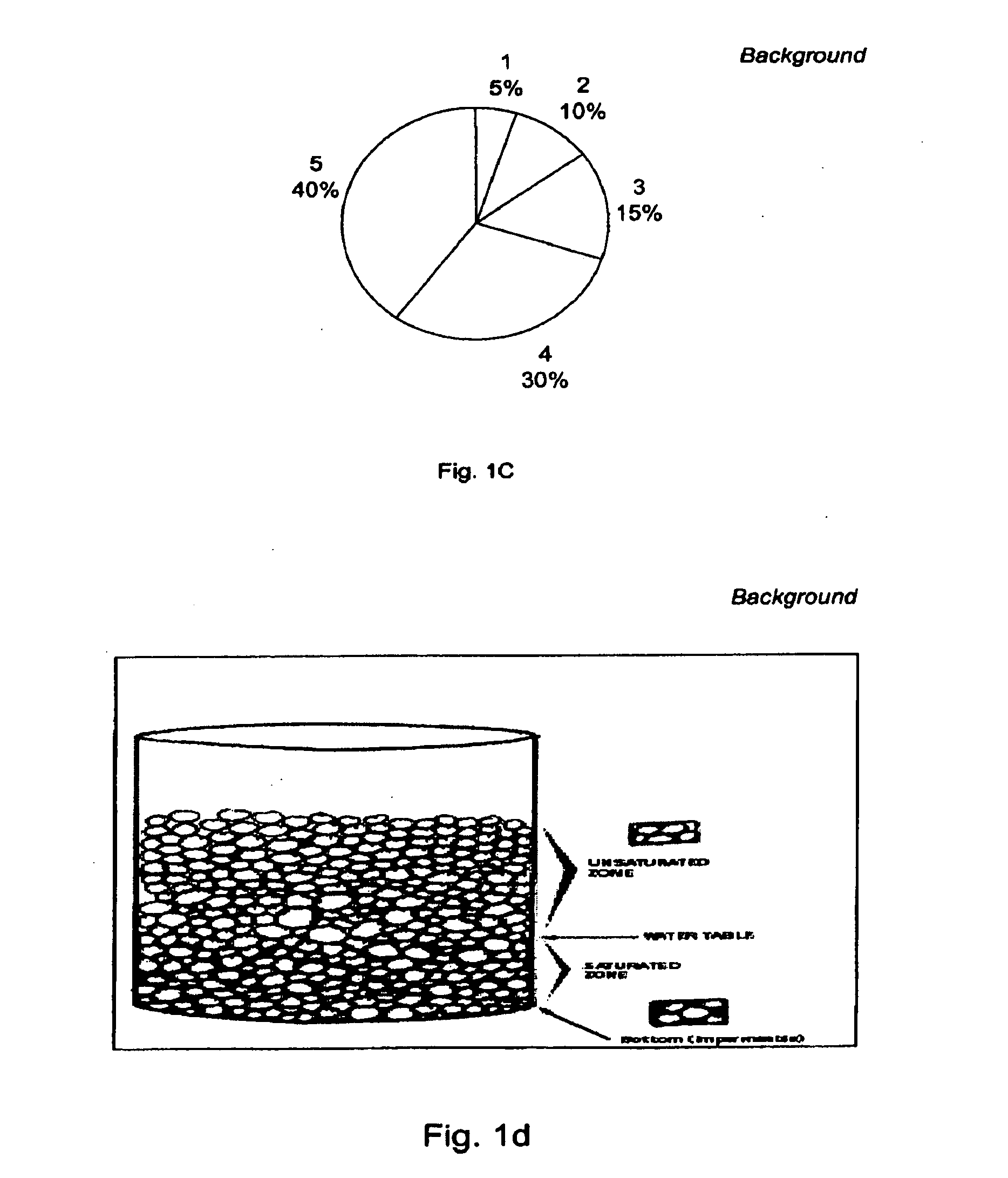[0019]One
advantage of providing a modularizable
system for residential
water treatment is the low
energy requirement to process water for reuse at the
residence which results in a reduction in the amount of fossil fuels required to power large
water processing stations and transfer water from water plants to individual residences. Another
advantage is the increased availability of water at the residential level in areas where water is a limited or limiting resource (e.g., in
arid climates). Still another
advantage of the invention is a reduction for a residence in the amount of water a residence uses in a given cycle due to more efficient reuse. Yet another advantage of the invention is the reallocation of water by quality for usage, e.g., use of treated gray water for
lawn care instead of blue water.
[0020]An aspect of the invention is directed to a
water treatment system. The
water treatment system comprises a settlement tank adaptable to receive
effluent from a source; at least one aerobic treatment tank configurable to receive a settlement tank
effluent; a disinfector adaptable to disinfect an
effluent from at least one of an
anaerobic treatment tank and an aerobic treatment tank; a tester configurable to test a parameter; and a controller configurable to control a process of the
water treatment system in response to the tested parameter.
[0021]The
anaerobic treatment tank is adaptable to be in communication with an anaerobic digester. Additionally, the anaerobic digester receives
sludge from the
anaerobic treatment tank. Furthermore, a parameter of an anaerobic
bacterial activity can be sensed by the tester.
Bacterial activity can then be adjusted by a controller in response to the sensed parameter. Moreover, the
aeration tank can be configured such that it is in communication with an
aeration source. The
aeration source can furthermore be configurable to deliver an aeration substance. Suitable substances include, for example: air, purified
oxygen, and
ozone. The rate at which the aeration source delivers the aeration substance, or the rate of the
water flow, can be controlled by a
regulator. Furthermore, in another aspect, a parameter of the aeration tank is sensed by the tester. For example, the rate at which the aeration substance is controlled, or the flow rate of the water through the system, is determined in response to a parameter measured by the tester. The disinfector can be one or more of an ozonator, an
ultraviolet light source, a heat source, a
distillation system, a
reverse osmosis system, and / or a
chemical treatment processor. In some embodiments, the disinfector is activated in response to a parameter measured by the tester. Furthermore, the system can be adapted to test one or more of
total dissolved solids, electrical
conductivity, temperature, color,
turbidity,
hardness, sediments, acidity, basicity,
calcium concentration,
magnesium concentration,
sodium concentration,
carbonate concentration,
chloride concentration, sulphate concentration,
sodium absorption ration,
boron concentration,
trace metal concentration, heavy
metal concentration,
nitrate-
nitrogen concentration,
phosphate-
phosphorus concentration,
potassium concentration, pharmaceutical compounds, hormones, and / or metabolic by-products. The tester can be controlled by a
timer and is configurable to test at a time interval. Furthermore the tester is configurable to provide real-time testing data to the controller, if desired.
[0022]Another aspect of the invention discloses a water treatment method. The method comprises: receiving an effluent from a source; aerobically treating the effluent received from the source; testing a parameter of the aerobically treated effluent; and adjusting the aerobic treatment of the effluent in response to a result of the tested parameter. The method can also include anaerobically treating the effluent from the source. Additional method can comprising the step of adding a reaction controlling substance. Additionally, the step of adding a reaction controlling substance is in response to the result of the tested parameter. One or more
filtration steps can be provided as well as one or more sterilization steps or processes. The sterilization step can be selected from an ozonator, a UV
light source, a heat source, a
distillation system, a
reverse osmosis system, and / or a
chemical treatment processor. Furthermore, one or more sterilization steps or processes can be selected which are then performed the sterilization in sequence, in parallel, or selectively in response to a tested parameter. Furthermore in some embodiments, the output from the system is tested. In other embodiments, the output of the system is reused onsite. Additionally, the step of separating the effluent received from a source can be performed.INCORPORATION BY REFERENCE
[0023]All publications, patents, and patent applications mentioned in this specification are herein incorporated by reference to the same extent as if each individual publication, patent or
patent application was specifically and individually indicated to be incorporated by reference.
 Login to view more
Login to view more 


